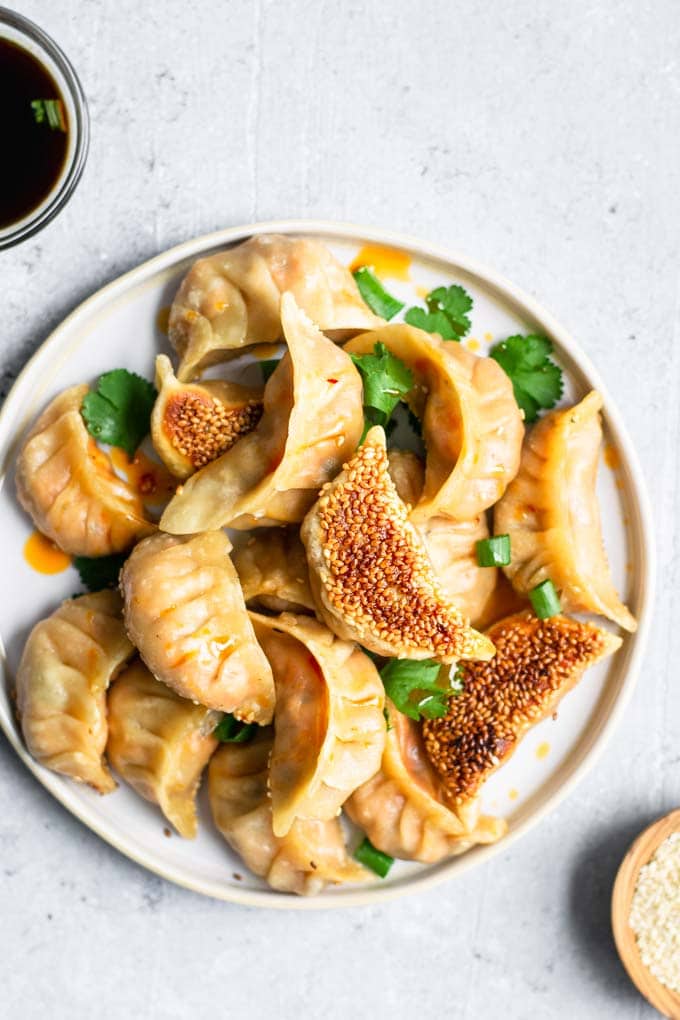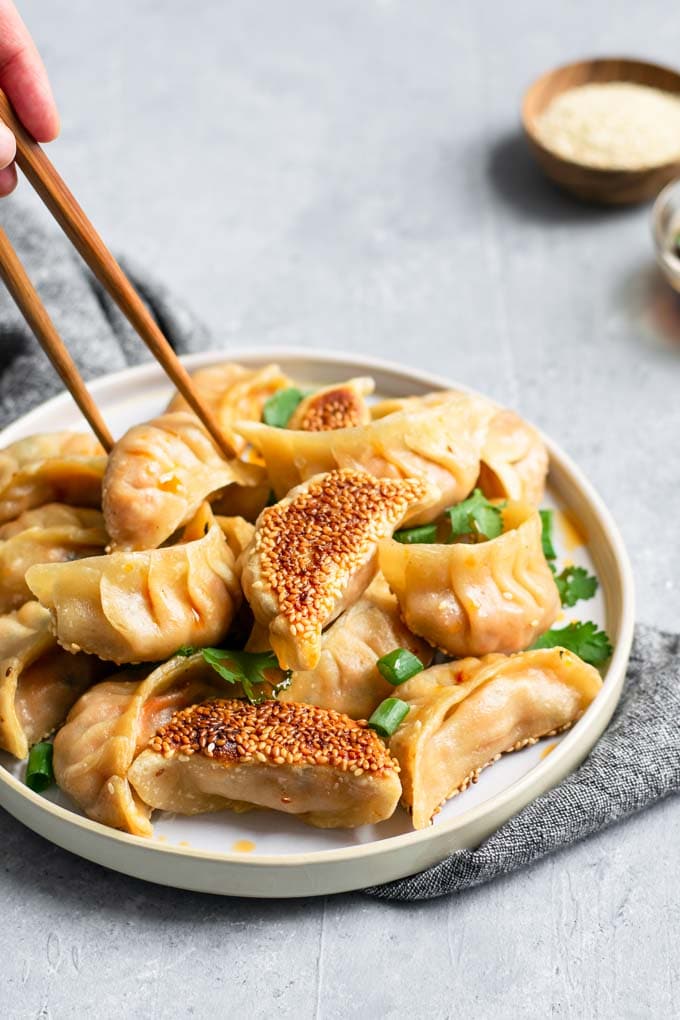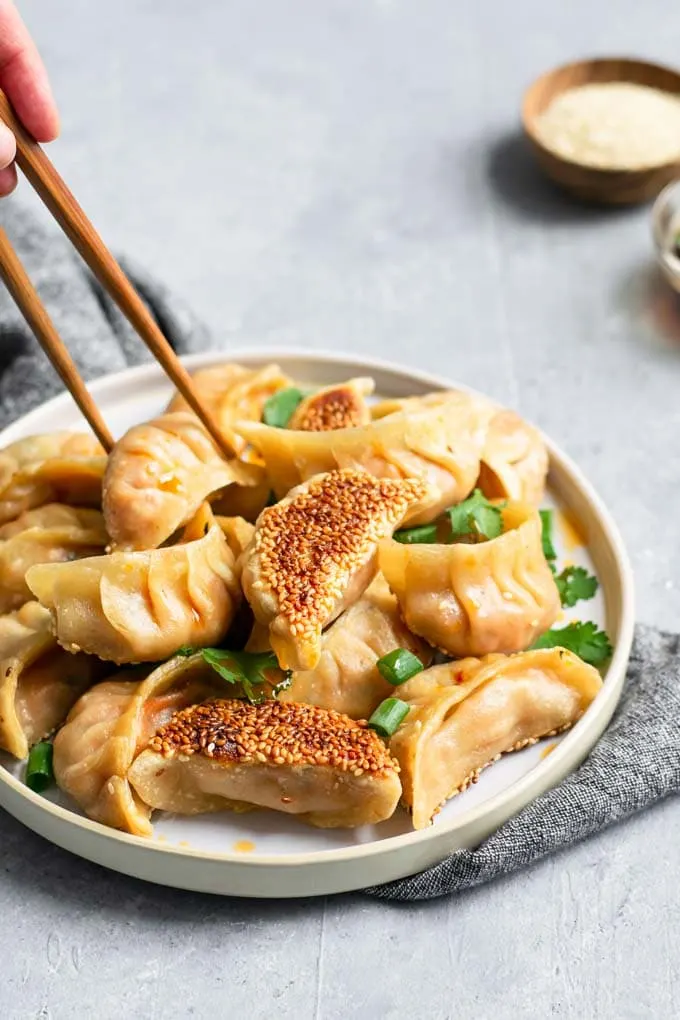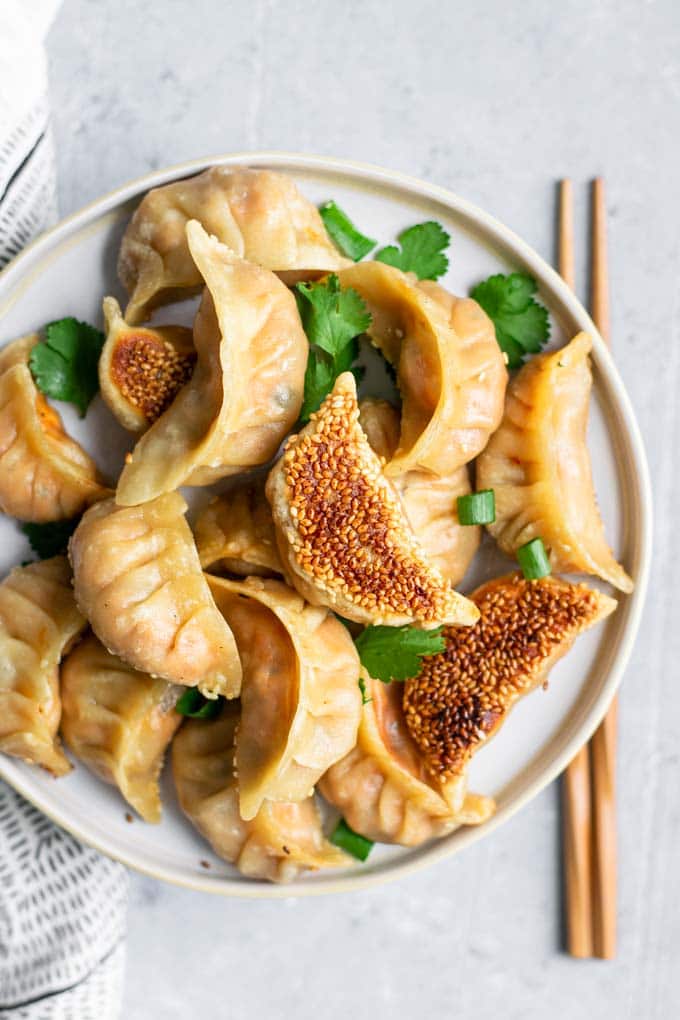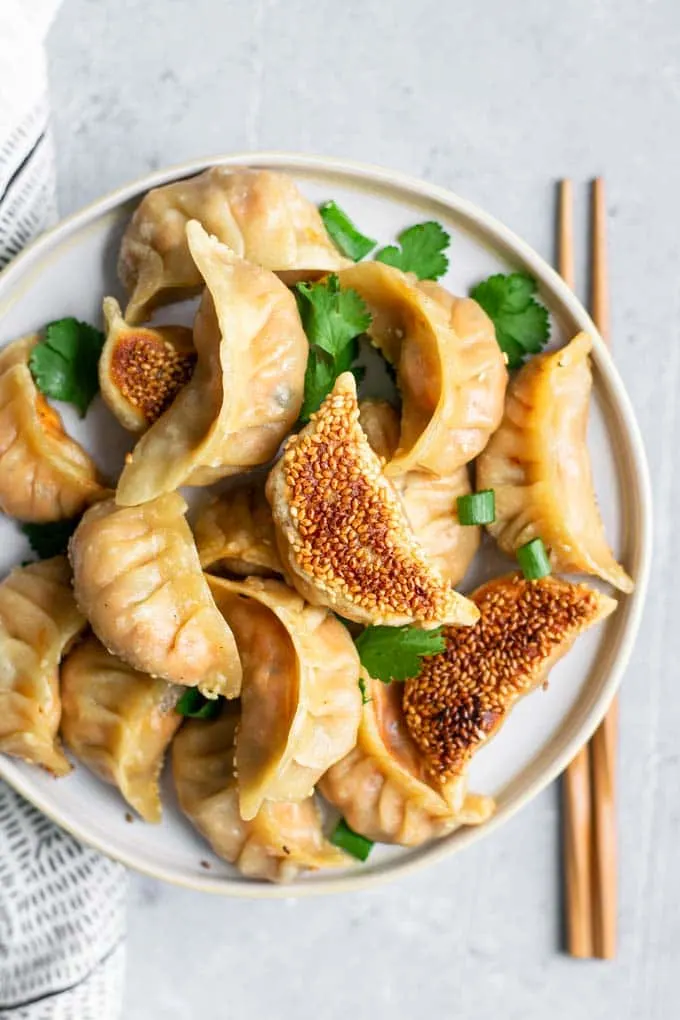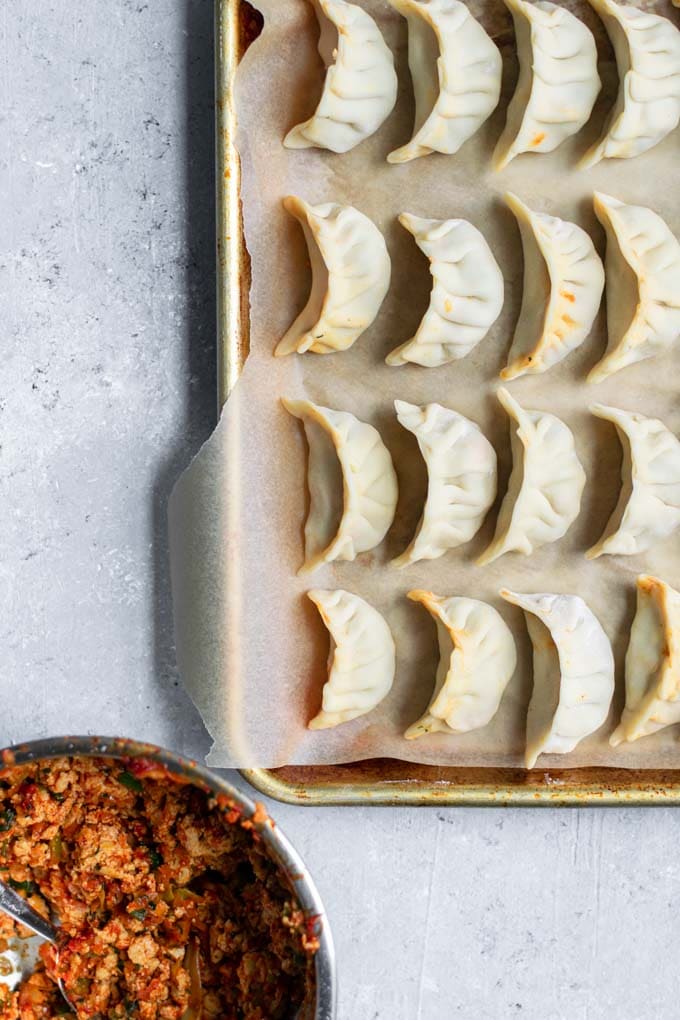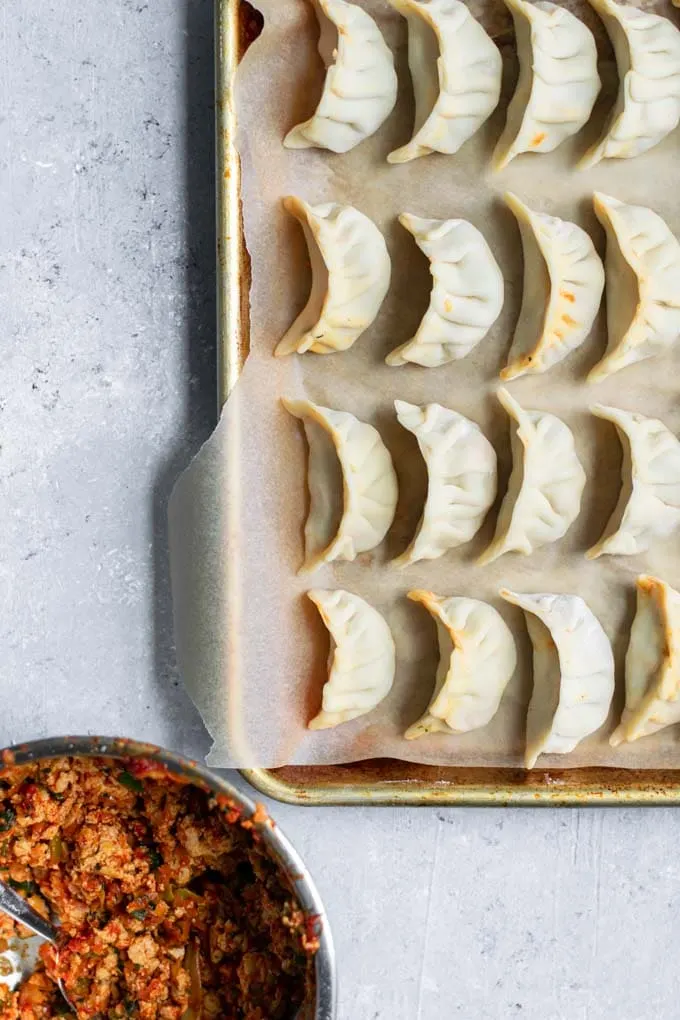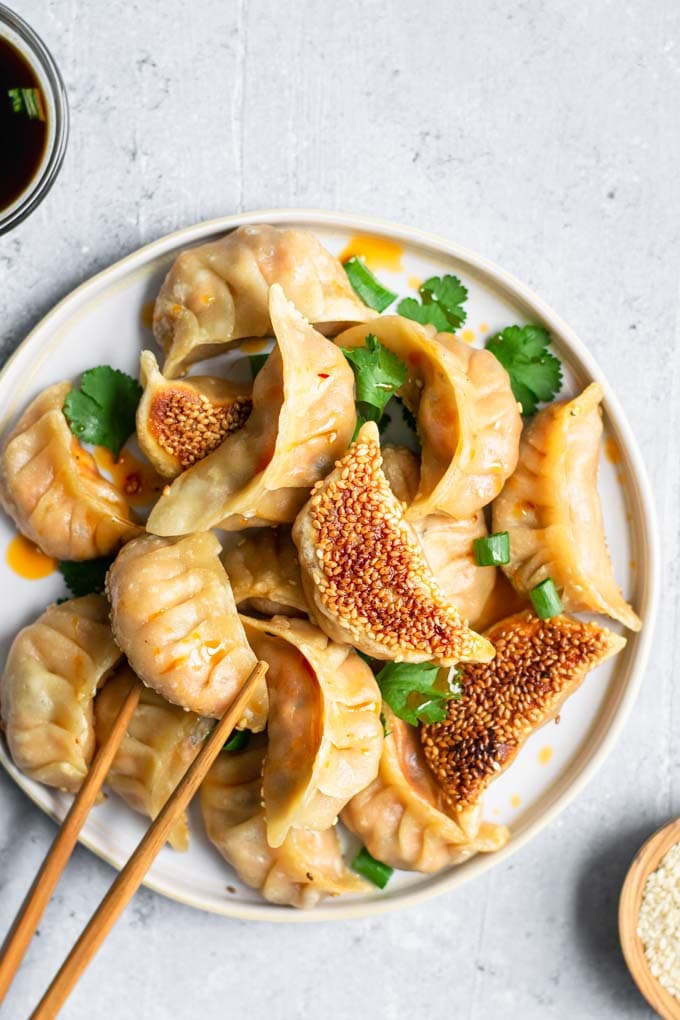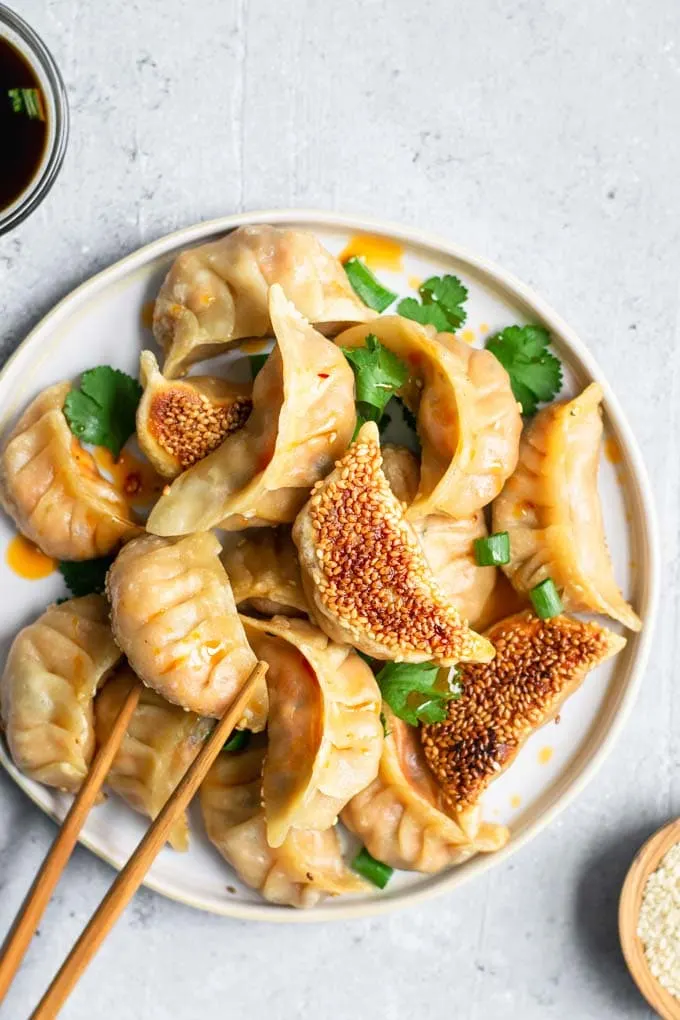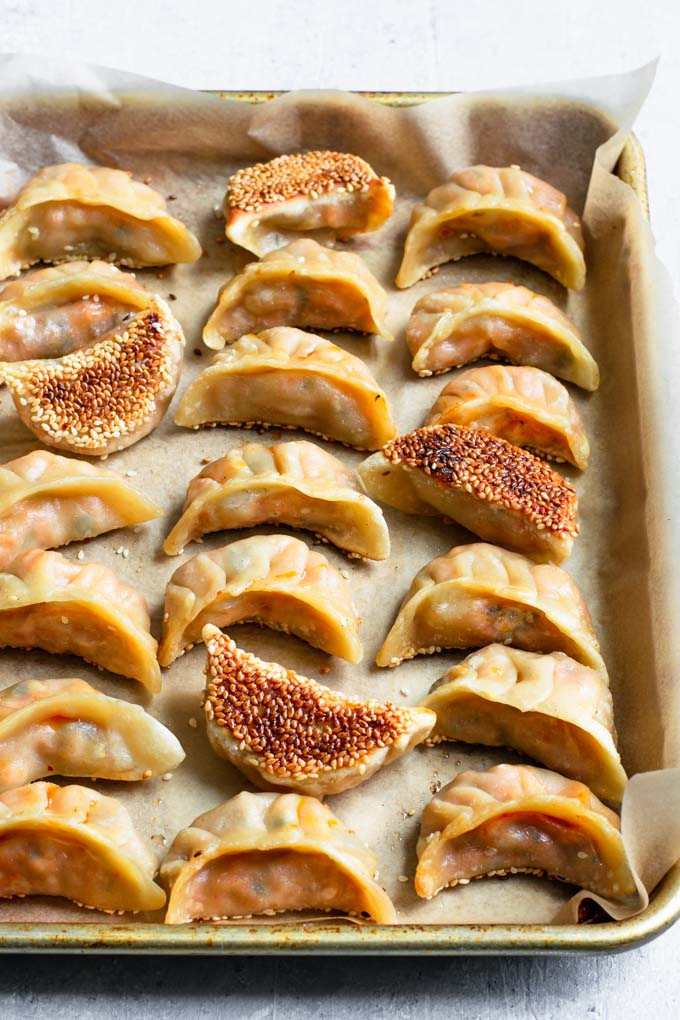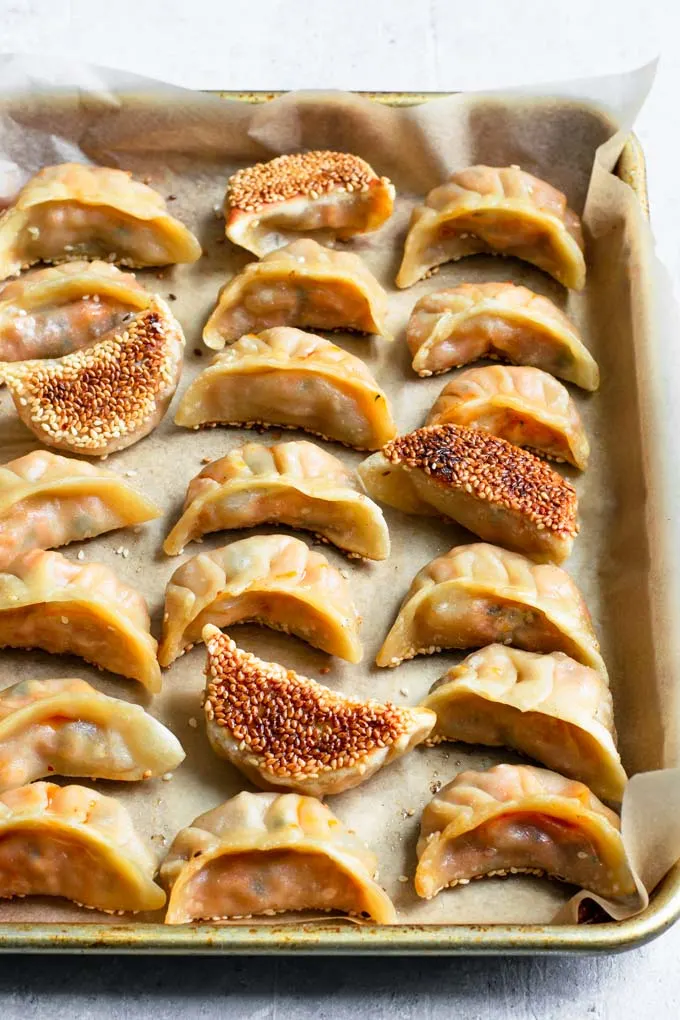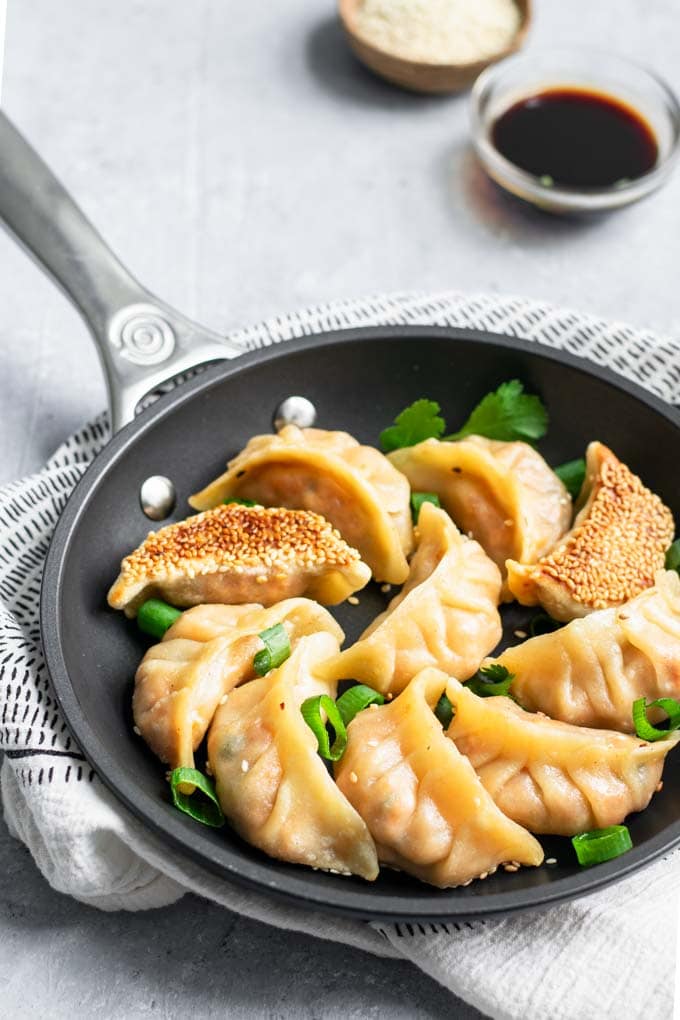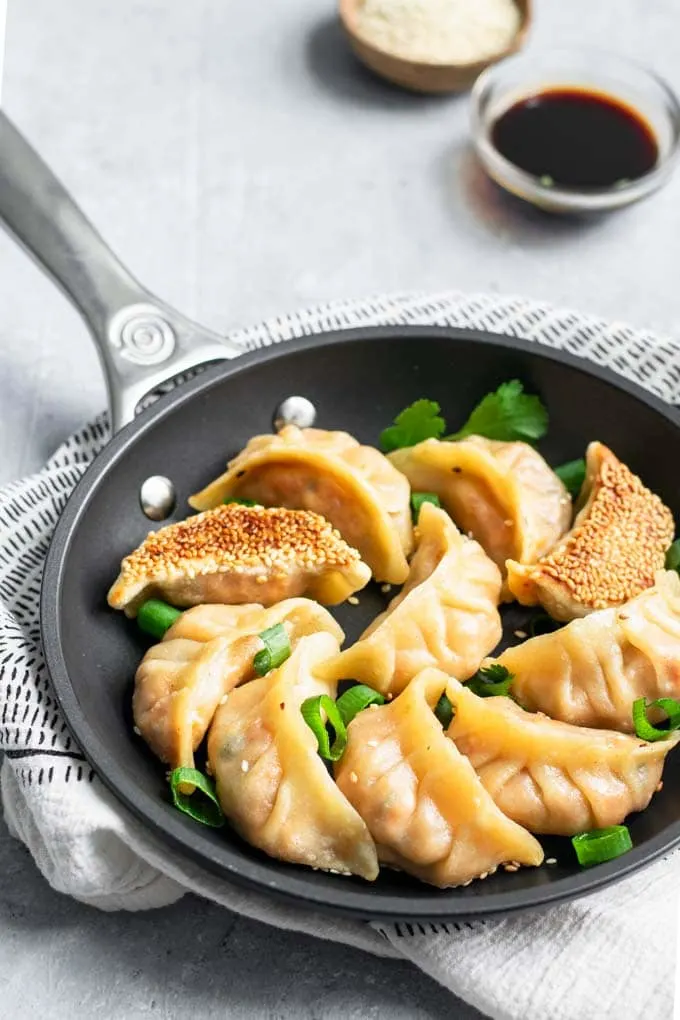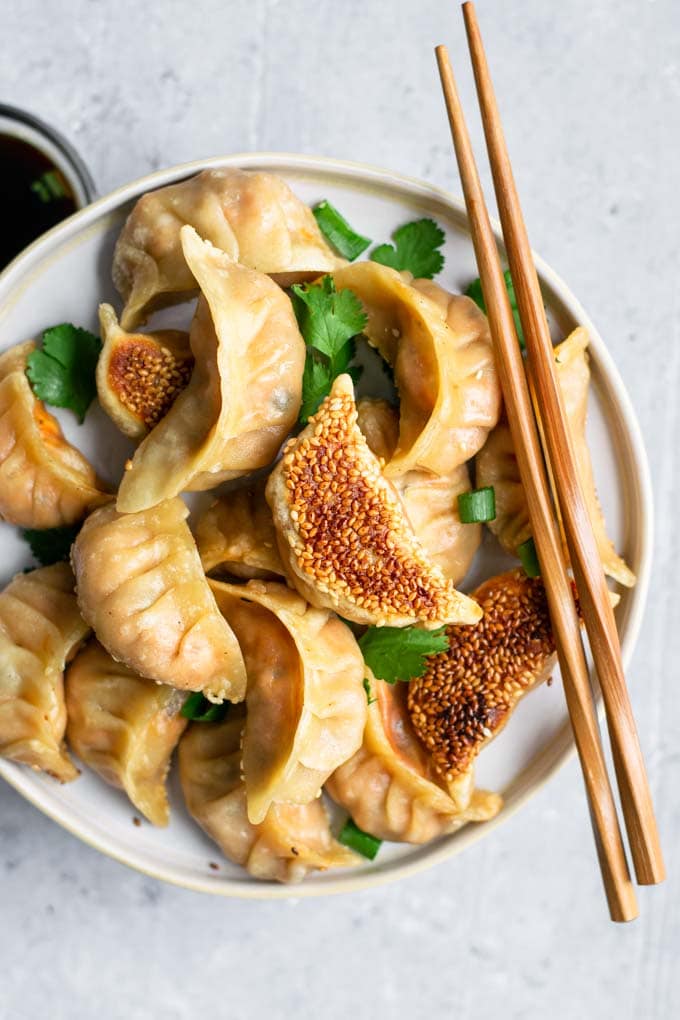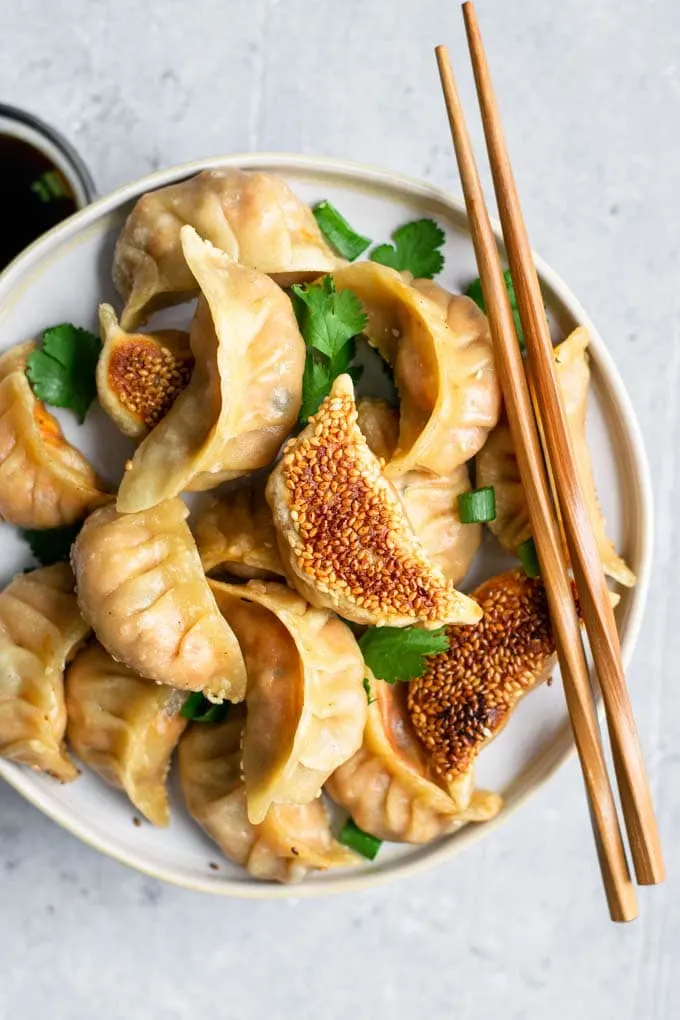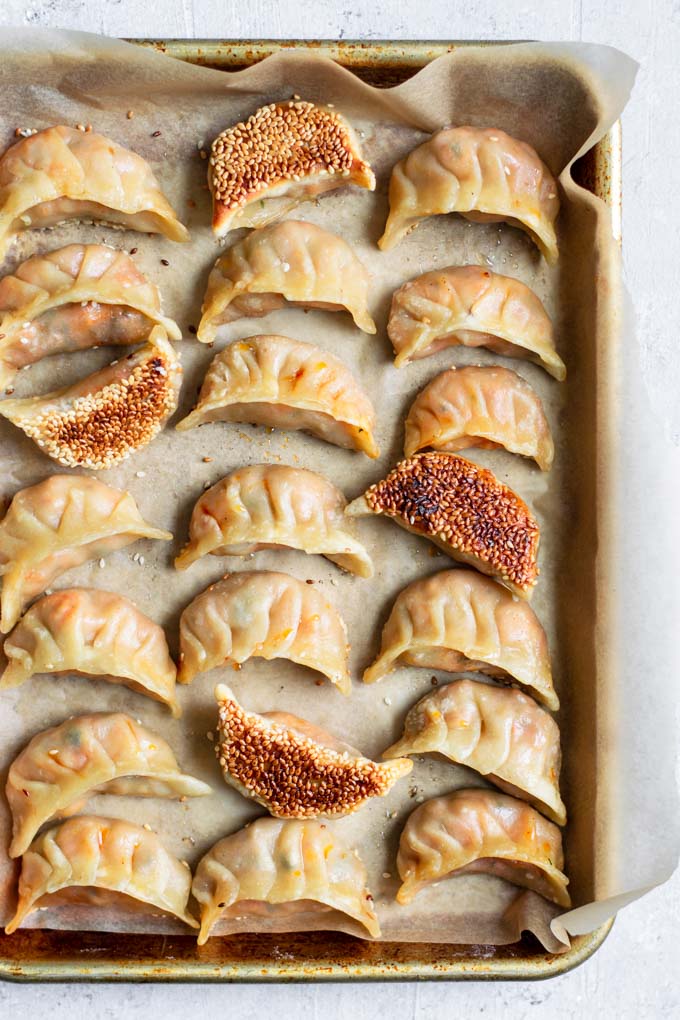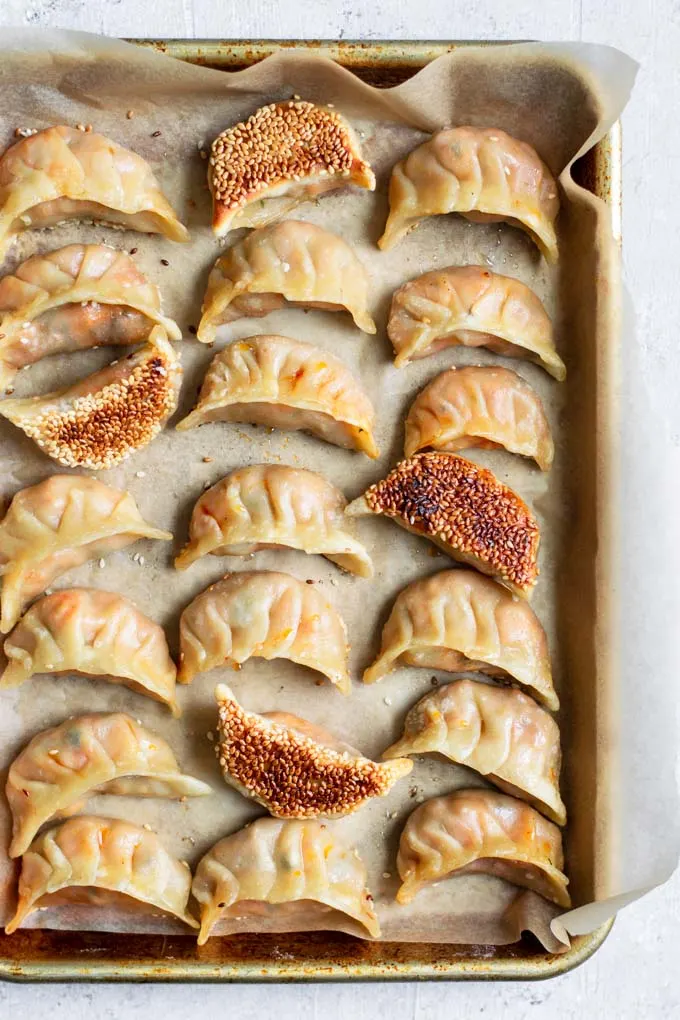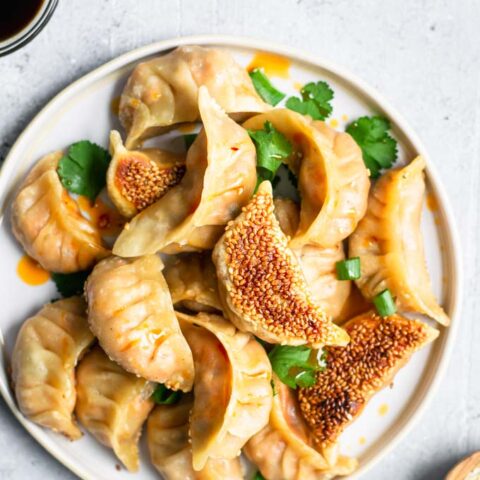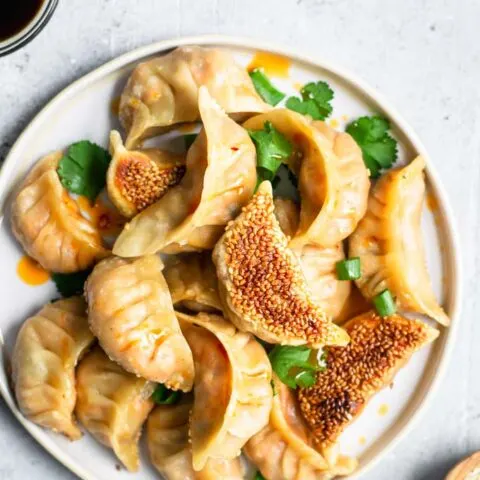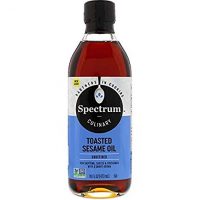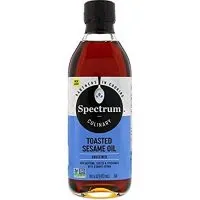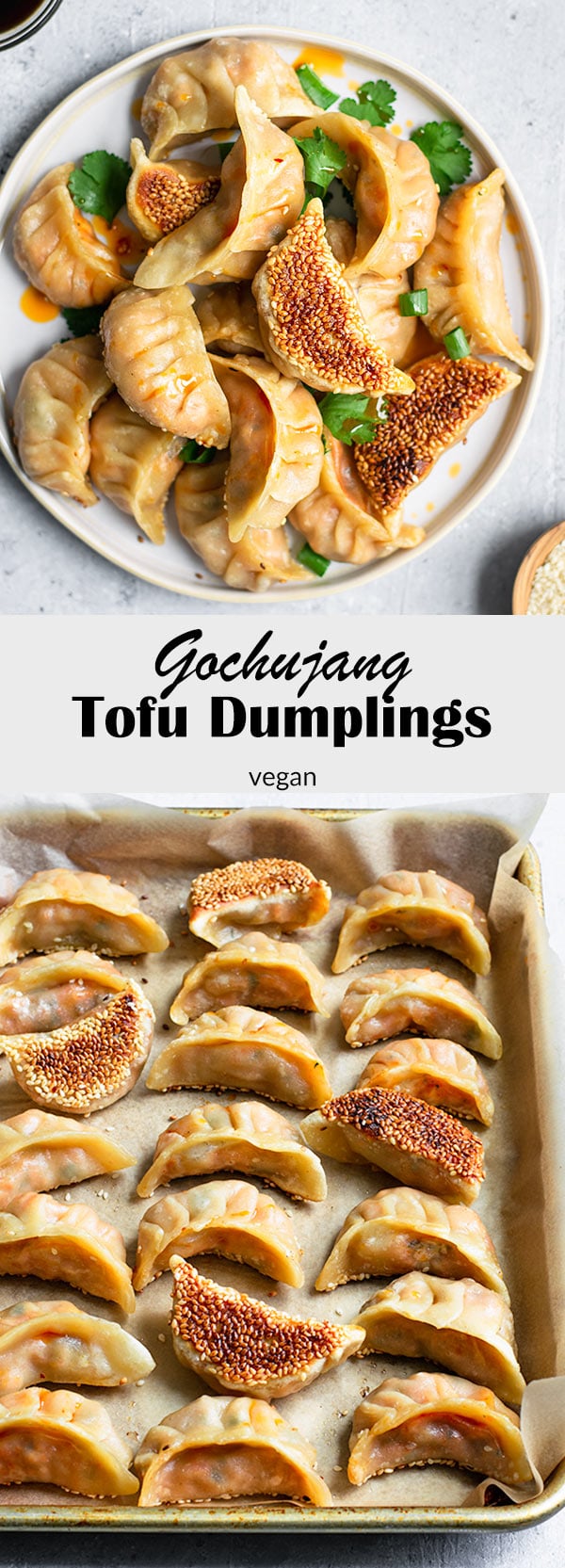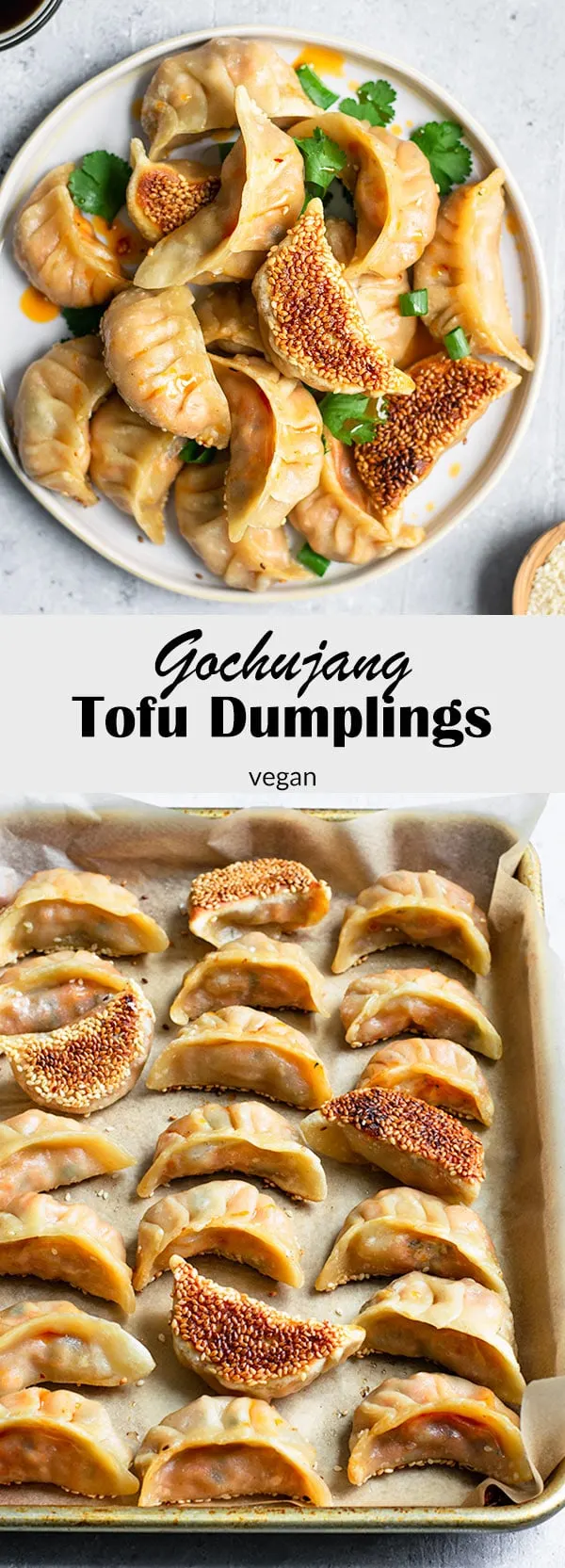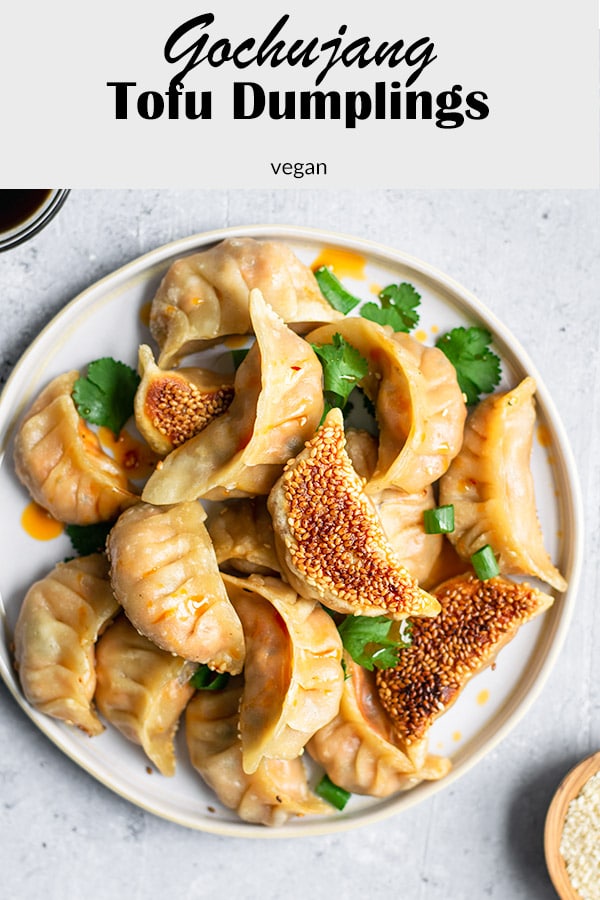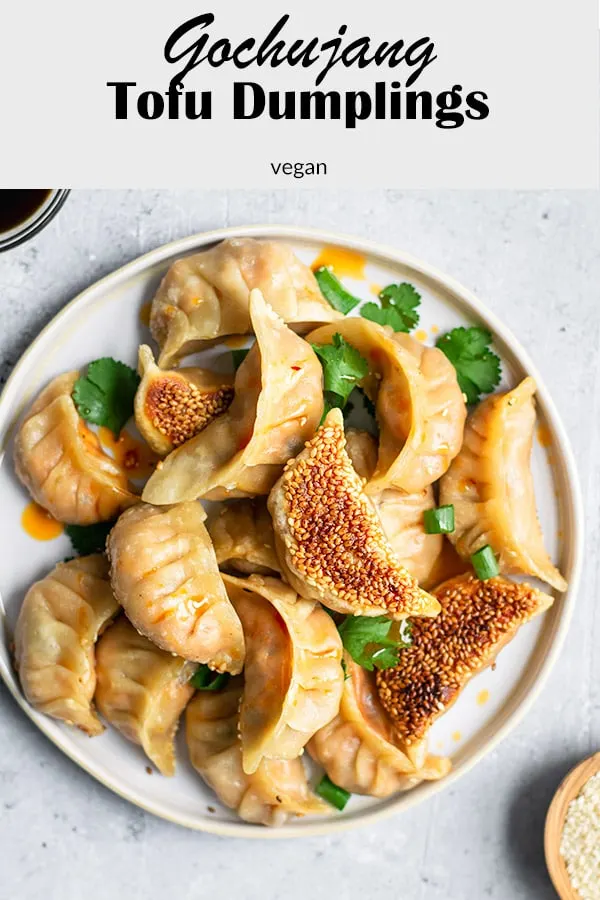If you love dumplings (aka if you’re human) then you need this recipe in your life. With crispy sesame seed bottoms and a spicy Korean pepper paste (gochujang), creamy crumbled tofu, and juicy cabbage filling. They’re SO good! Possibly even the most perfect two-bite sized food there is! They’re just bursting with flavor and perfect for dipping. If you’ve resisted the allure of making your own dumplings/gyoza/potstickers from scratch in your very own kitchen for your eating pleasure, it’s now time to change that. And if you’re a seasoned dumpling maker, you know how incredible homemade ones are and need to add this recipe to your to-make list! Homemade dumplings might not be the quickest food to make, but there’s nothing difficult about it either. A little patience, some music or TV on in the background, and if you’re lucky some dumpling-shaping company, and you’ll have them done before you know it!
For streamlined dumpling making follow these steps:
If you’d prefer you can make the filling in advance and then make the dough the day you want to cook them. You can also make and shape them in advance and freeze them until you’re ready to eat. If frozen, they will take longer to cook!
The gochujang tofu filling:
The Korean-inspired filling for these dumplings couldn’t be easier to make. There are just 11 ingredients and it takes about 10 minutes to cook. The bulk of the filling is tofu and cabbage. Choose a firm or extra firm tofu, and press it to squeeze out extra water before cooking. Pressing tofu is a cool trick to make for a firmer and less delicate, easier to cook, and just gives it a better texture. Take a block of tofu, wrap it in a lint-free towel or paper towels, and then put something heavy on it. Let it sit for 20 minutes or more to press out the excess water, then crumble up the block of tofu. If you’re in a hurry, you can give the block of tofu a good squeeze between your hands over a bowl to get rid of excess water, and then note it may need a bit longer to cook so it’s not too wet of a filling. Prep your other veggies: finely shred the cabbage and chop up the green onions, garlic, and cilantro. Whisk together gochujang, hot water to thin, toasted sesame oil, and soy sauce and set it aside. If you’re unfamiliar, gochujang is a Korean hot pepper paste. It’s sweet, salty, fermented and amazing. The spice level in gochujang varies a lot by brand, I’ve found spicy ones at Asian grocery stores and mostly mild ones in the International foods section of my local grocery stores. Personally, I’m a huge fan of the spicy ones, but if you’re spice sensitive then feel free to start with less and add more to taste! Once all your ingredients are prepped and sauce is mixed together, cook it up! Fry the crumbled tofu, add the cabbage, garlic, and green onions and cook those as well. Then toss in the sauce and let it cool.
Homemade dumpling dough:
In my dream life I live near a place where I can buy egg-free dumpling/wonton wrappers so I can make dumplings as often as I want. But I don’t, and honestly making dumpling dough is easy! You need 4 ingredients: flour, salt, a little bit of oil, and boiling hot water. A stand mixer makes it easy to bring the dough together, but you can also knead by hand. Knead the mixture into a soft and supple dough, then let it rest for 20 or so minutes before dividing it into pieces and shaping the dumplings. The resting time allows the flour to fully hydrate and the gluten (protein structure of wheat) to relax for easy rolling. For my Tibetan momos I rolled out the dumpling dough in big sheets and then cut it into circles. For these I divided the dough into small walnut-sized portions and rolled each one out individually. Either way works and you can use either method for these, but we’ll proceed with the latter instructions. Roll out each piece of dough into about a 4″ circle, dust the surface with flour and the dough so that it doesn’t stick. It doesn’t need it to be a perfect circle, any imperfections and lopsided edges will be hidden when you shape the dumplings.
Shaping the dumplings:
If you’re new to shaping dumplings, start with rolling and filling one or two wrappers at a time. This way you can make adjustments with rolling the dough out thinner or thicker with subsequent pieces of dough as well as figuring out how much filling to add. Before you fill any dumplings, it’s helpful to watch some videos of other people shaping dumplings. I meant to film one for you, but ran out of time (probably just an excuse to remake this recipe asap)! Until I do, check out this dumpling shaping video on youtube (note: the filling is definitely not vegan). I like the ‘one direction crescent moon’ and ‘two direction crescent moon’ shapes. You can also always shape them similarly to how I shaped my Tibetan momos, and I did share a video of how I shaped those, so go ahead and check it out if you’d like! For a written explanation of how to fold let’s first start with the two direction pleated crescent moon shape. I found this method to be easier as a beginner dumpling shaper. To make the one direction pleated crescent moon shape: Place shaped dumplings on a piece of parchment paper so that they are not touching to prevent any sticking. Continue shaping, making adjustments to your technique as you go for streamlined dumpling making. No matter how pretty (or not) they come out, they will be super delicious!
Cooking the gochujang tofu dumplings:
If you’re like me, you enjoy a nice crispy bottom to your dumplings, but also appreciate the chewy texture that steamed dumplings get. Luckily there’s a great combo cooking method that takes the best of both worlds (aka dumpling cooking methods). Best part: no fancy equipment needed! Just a skillet and a lid or something that functions like a lid (anyone else use baking sheets as lids for their large skillets? Just me? Note to self: buy XL lid). But first, if you’re using this method, you have the option of coating the bottoms of your dumplings in sesame seeds. To do so, dip the shaped potstickers in a water just to dampen the bottom, then dip it into a plate covered in sesame seeds. Place back on the parchment paper and repeat until all your dumplings are properly sesame seeded up! Ok, now we heat up a skillet over medium, drizzle in oil to lightly coat the bottom of the skillet, and place your dumplings in sesame seeds down (or bottoms down if you’re skipping the sesame seeds). Let the dumplings fry for a couple of minutes, then pour in water and cover. The water will splatter when it hits the hot oil, so I recommend putting the lid down so it’s slightly ajar in a direction that is facing away from you, then pouring the water in and immediately closing the lid completely. Let the gyoza steam for about 5 minutes (add a minute or two if cooking from frozen), then take the lid off. At this point check the bottoms of your dumplings, if they’re nice at golden you’re done! If they aren’t quite there, let them cook with the lids off until they reach the desired level of crisp.
Dipping sauces!
There’s nothing like enjoying hot, spicy, crispy bottomed-chewy dumplings dipped into a salty rice vinegar-spiked soy sauce. The dumplings themselves are not overly salty, and soaking up some salty sauce just makes them that much better. I’m not giving an exact recipe for dipping sauces with this post. Mostly because I never really measure when I’m making soy sauce dipping sauces, but also because ya don’t need a full recipe! You’re welcome to do your own thing but this is what I did. Mix together soy sauce, with a small drizzle of rice vinegar (I love vinegar so I often add a bit more than a drizzle), and an even smaller drizzle of maple syrup (or date syrup, or even regular sugar but you’ll have to work a bit harder to dissolve it). Taste and adjust the ratios to your liking, then add some sliced scallion greens and a sprinkling of sesame seeds. Note: For the soy sauce, I always use reduced sodium tamari, if you use full sodium tamari or shoyu you may want to dilute a smidge with water. Other options include adding a few drops of chili oil or toasted sesame oil to the dipping sauce (be careful not to add too much or it will taste oily), or a squirt of hot sauce or a spoonful of gochujang. It’s really whatever you like! Alright, this turned into a super long post, but hopefully it’s filled with helpful tips and instructions so you feel confident enough to tackle dumpling making! It’s really quite fun to do, and I find the repetitive task of filling and shaping the gyoza to be quite relaxing and cathartic. If you make these gochujang tofu dumplings, leave a comment below and rate the recipe on the recipe card. And please share your photos with me on Instagram, tag @thecuriouschickpea and #thecuriouschickpea, I love seeing your remakes!
Notes:
You will likely have leftover filling, you can either increase the amount of dumpling dough you make or enjoy the leftover filling with rice for a tasty snack or light meal. To freeze the dumplings: set them on a parchment lined plate or tray and stick them in the freezer. Once frozen through and hardened, transfer to a freezer safe storage (tupperware, ziplock bag). Cook them straight from frozen, just note they will take longer to cook!
Like Gochujang? Check out these recipes!
Gochujang Peanut Noodles with Patty Pan Squash *To press tofu wrap in paper towels or a lint free towel and place a plate or cutting board and some heavy items on top. Let sit for 20-30 minutes to press out excess water. Make an easy dipping sauce with soy sauce, a small drizzle of rice vinegar, and a little maple syrup or other liquid sweetener. Add some sliced scallions and sesame seeds. Adjust ingredients to taste!
CJ Haechandle Gochujang, Hot Pepper Paste, 1kg (Korean Spicy Red Chile Paste, 2.2 lbs.) San-J Organic Reduced Sodium Gluten Free Tamari Soy Sauce -- 20 fl oz - 2 pc Spectrum Toasted Sesame Oil, 8 oz San-J Organic Reduced Sodium Gluten Free Tamari Soy Sauce -- 20 fl oz - 2 pc
Vegan Gochujang Bean Burgers Gochujang Tempeh Wings
